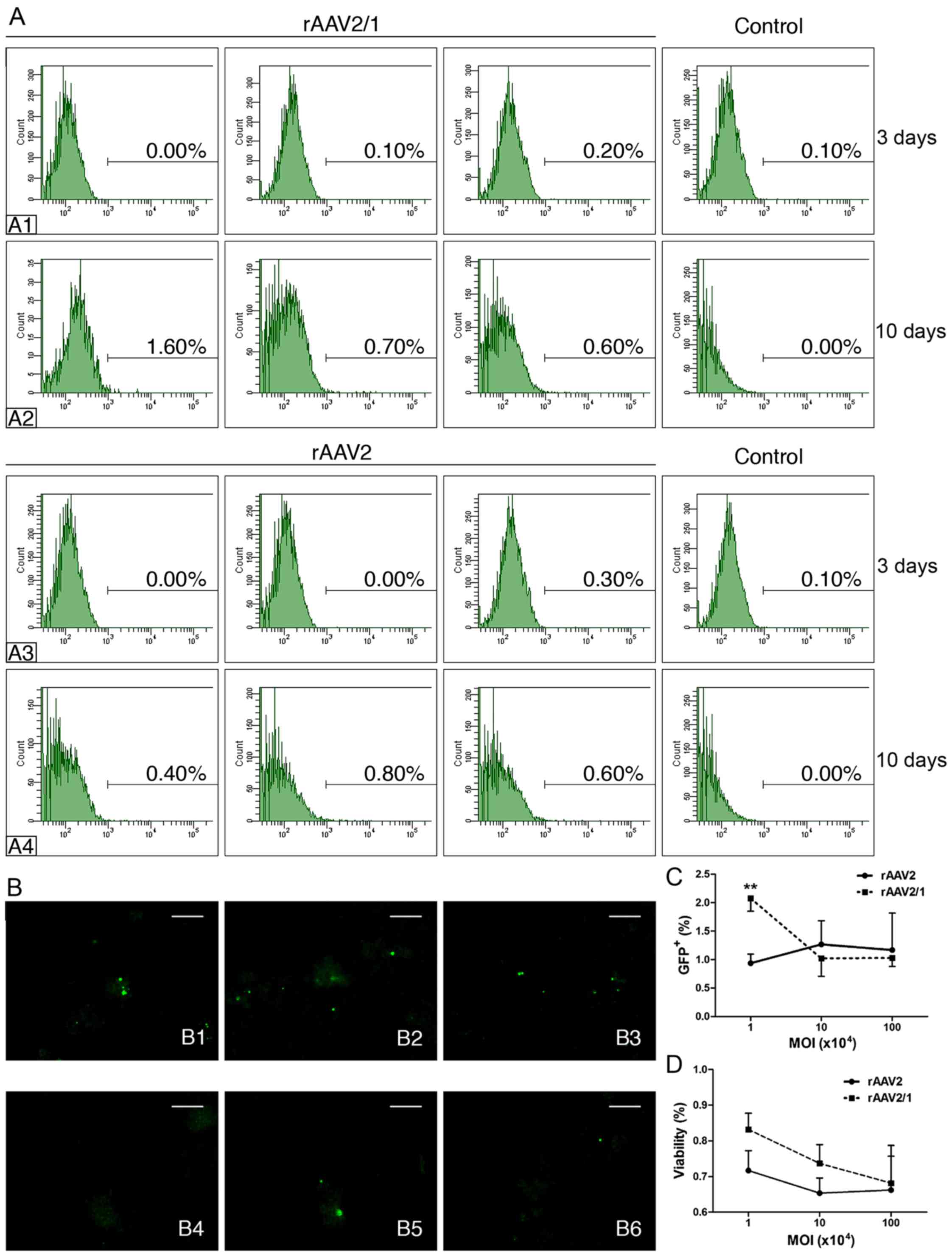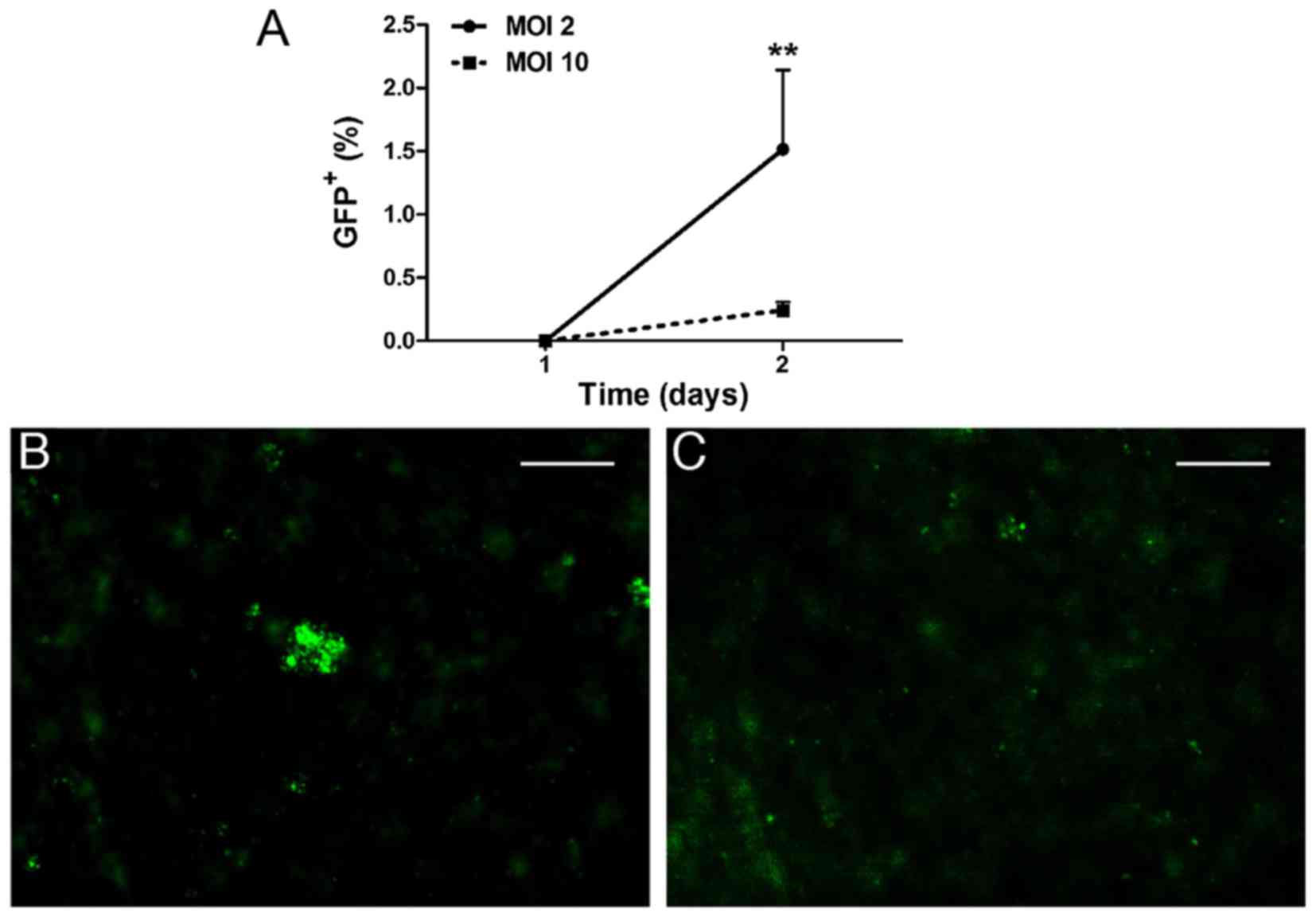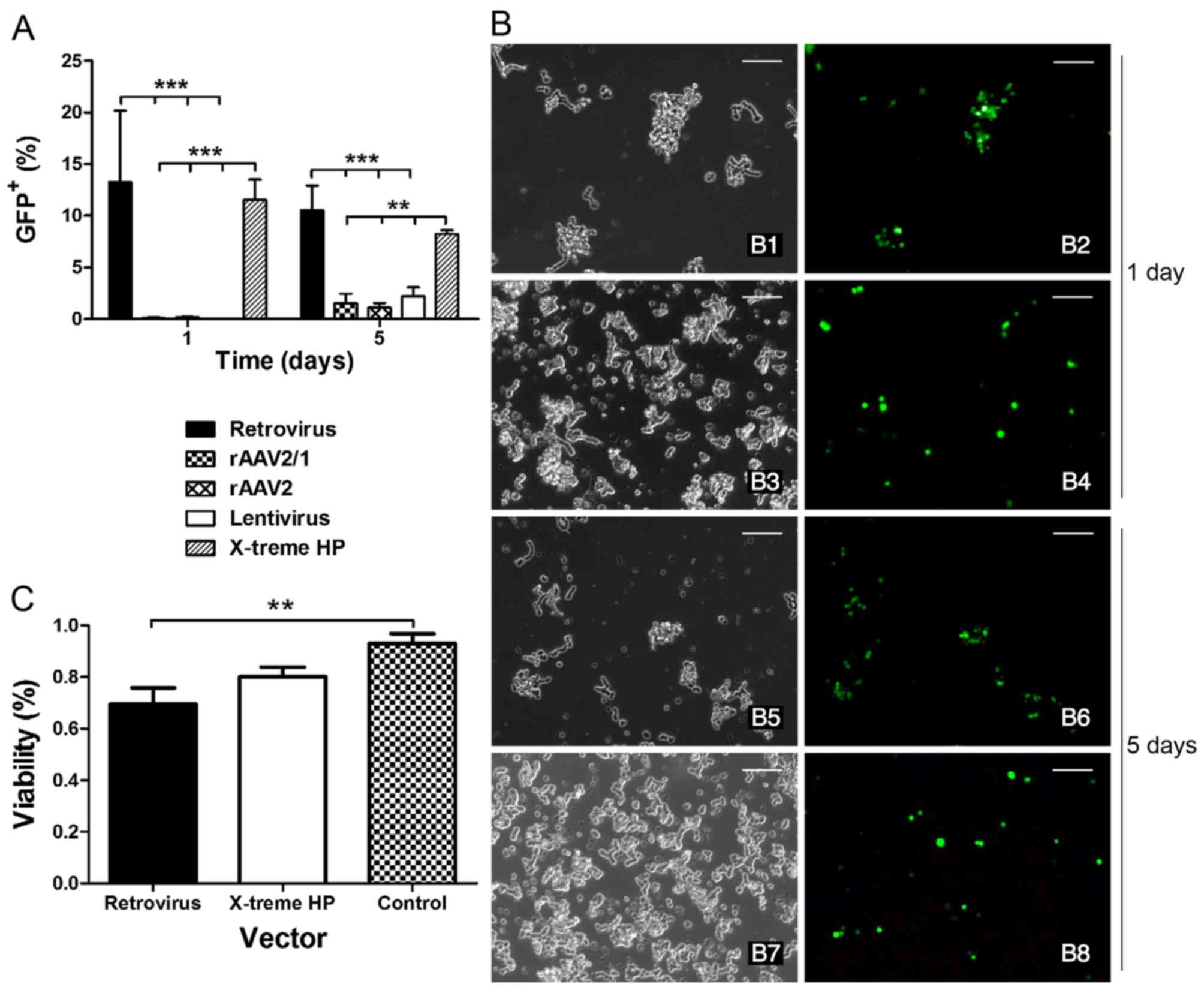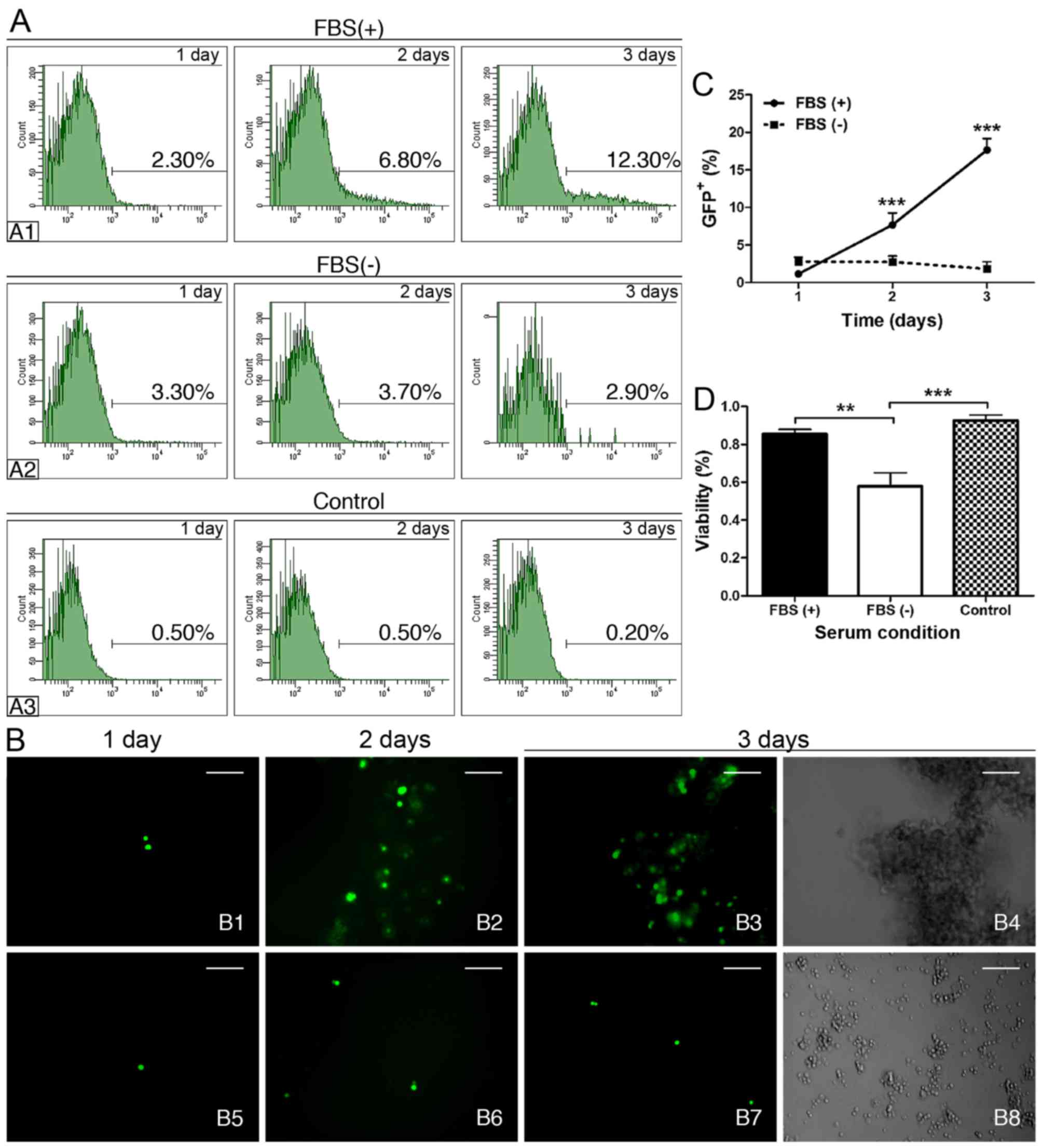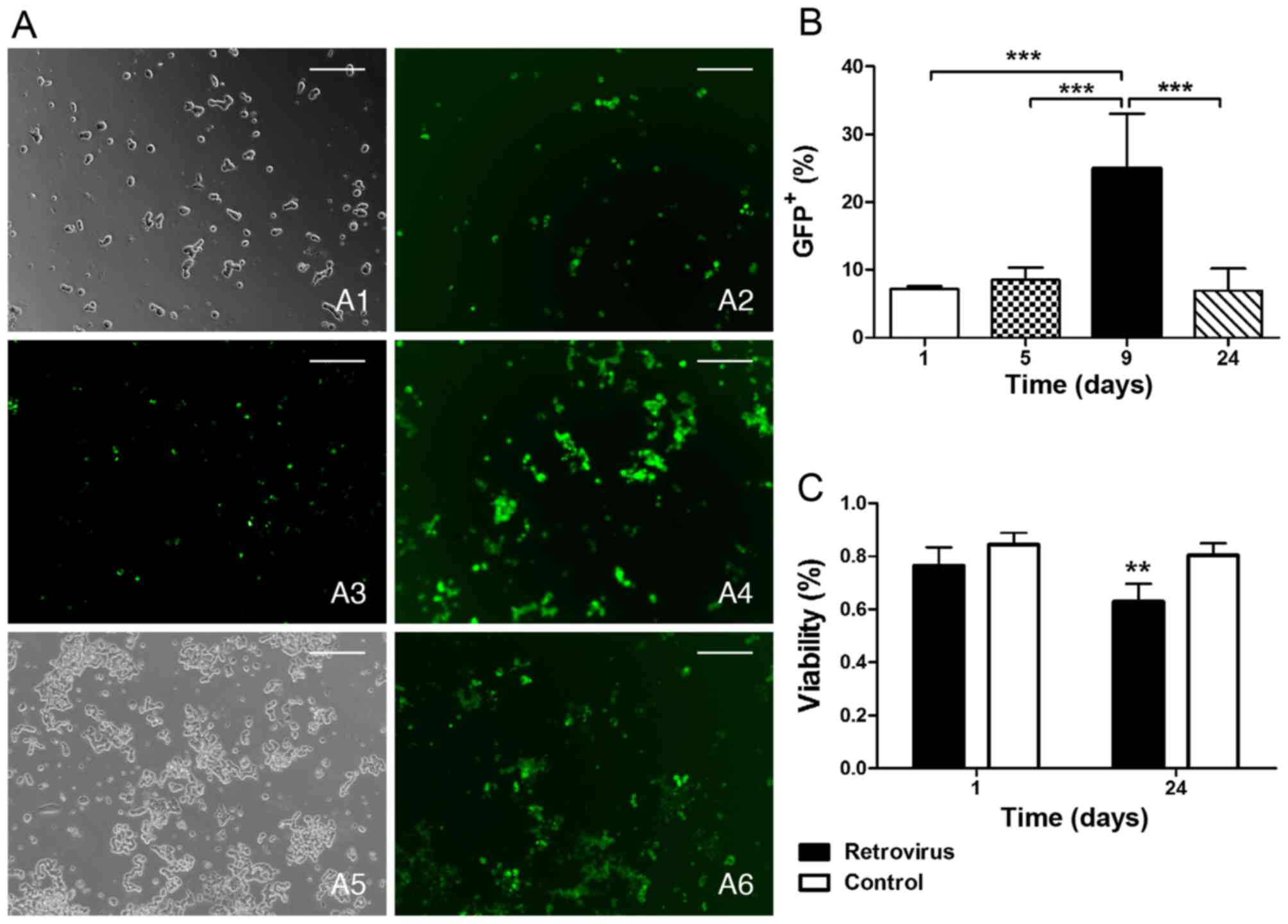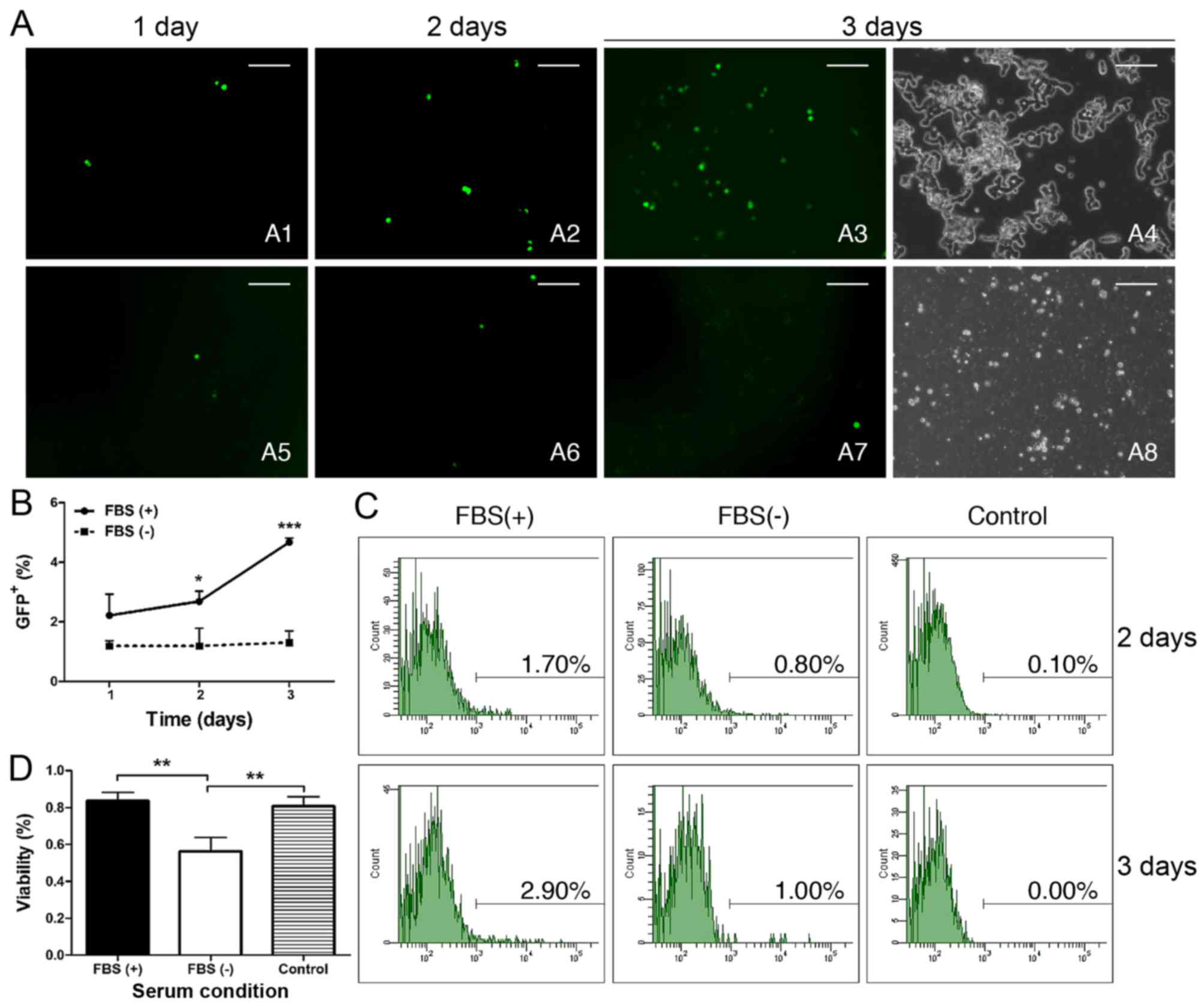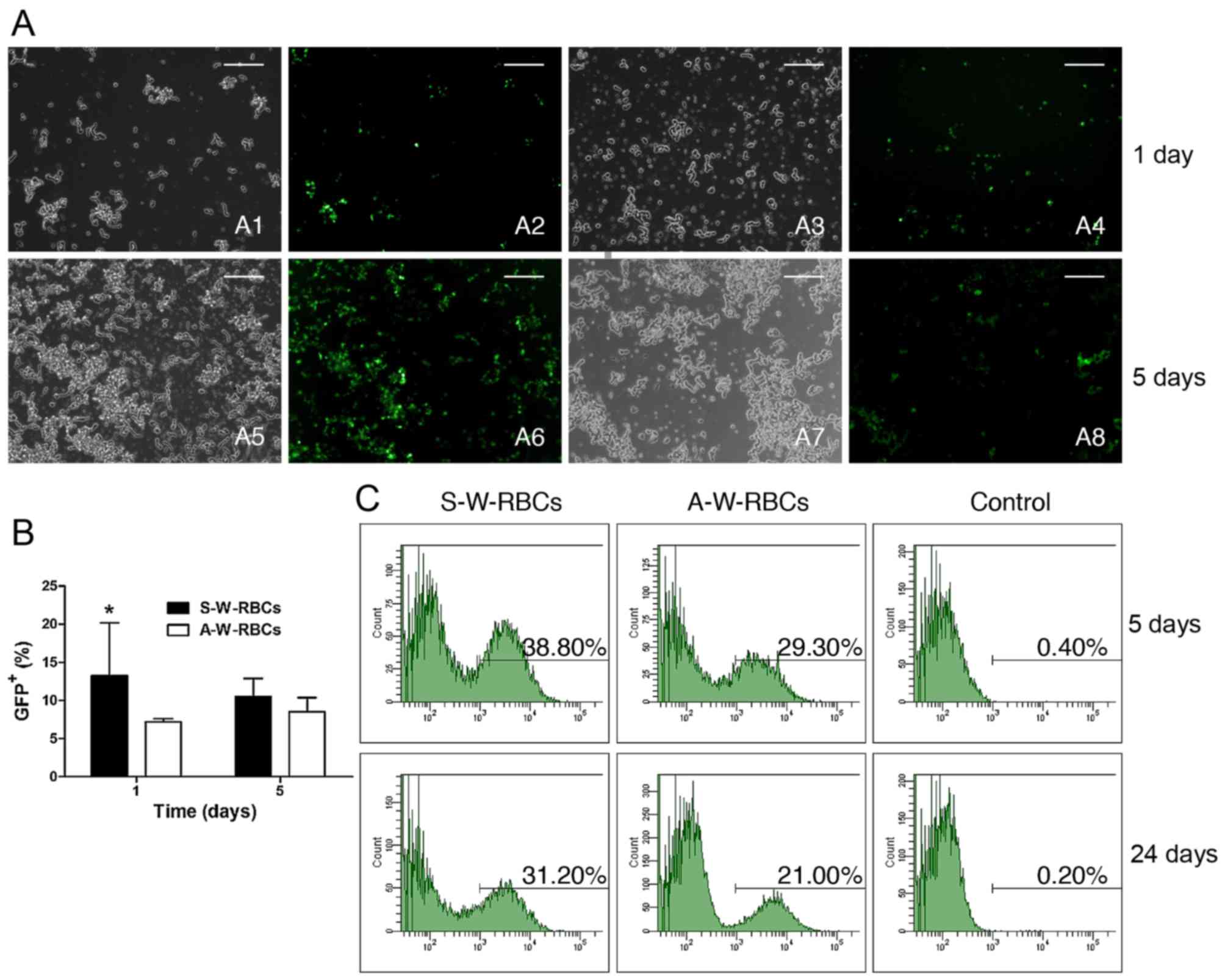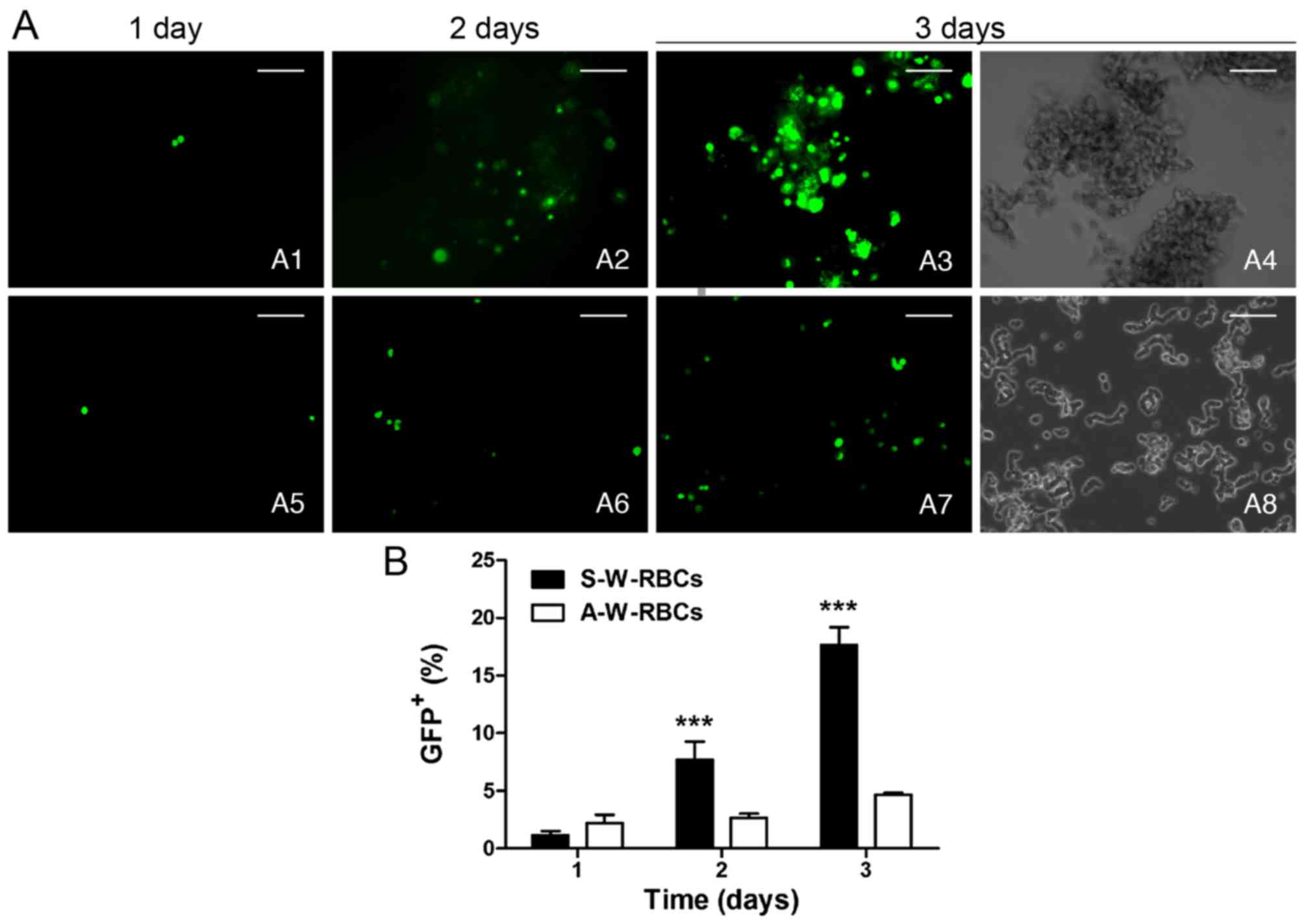An optimized gene transfection system in WERI-Rb1 cells
- Authors:
- Published online on: July 6, 2017 https://doi.org/10.3892/ijmm.2017.3058
- Pages: 801-813
-
Copyright: © Liu et al. This is an open access article distributed under the terms of Creative Commons Attribution License.
Abstract
Introduction
Retinoblastoma is the most frequent intraocular malignancy in children, with a worldwide incidence of 1/16,000-1/18,000 live births (1). Although current therapies have achieved considerable improvements, there are still unsolved issues: secondary tumor growth (2), optic nerve damage (3), and normal retina impairment caused by nonspecific chemotherapy and radiation (4,5).
A novel therapy for tumors is gene therapy. Compared with conventional therapies, gene therapy has exhibited several advantages, such as specific regulation and a longstanding effect in a controlled manner. There have been 2,388 clinical trials that have investigated gene therapy for several tumors or cancers, such as brain tumors, breast cancer, and prostate cancer. Among the 699 completed trials, many have shown the effectiveness of gene therapy as a valuable supplement and even a novel approach to tumor/cancer therapy.
Inactivation of the Rb1 gene alley, the major cause of retinoblastoma, has made gene therapy a promising treatment for retinoblastoma patients. In fact, several types of genes, including the suicide gene (e.g., HSV-TK/GCV) (6,7), anti-oncogenes (e.g., Rb1, P21 and P53) (8,9), and anti-angiogenesis genes (e.g., sFlk21 and ExTek) (10,11), have been transfected into retinoblastoma cells to inhibit their proliferation or to induce their apoptosis.
Successful gene therapy is based on an appropriate transgene vector; however, previous studies have mainly focused on the function of transgenes rather than the vectors. A few types of transgene vectors have been randomly adopted for retinoblastoma gene transfection, including the adenoviral vector (6,7), the liposome (12), and some uncommon vectors such as the encephalomyocarditis virus (13). There is no systemic evaluation of these vectors, and there is also a lack of evaluation of other vectors that are utilized more often. Thus, it is crucial to systematically optimize proper gene vectors for retinoblastoma cells.
Generally, the present gene vectors are classified as viral- and non-viral vectors. Various viral vectors have been adopted to transfect the retina. Among them, vectors based on retroviruses, recombinant adeno-associated viruses (rAAVs), and lentiviruses (LVs) are the most commonly used. These vectors were assumed to be effective in retinoblastoma transfection, considering the retinal origin of retinoblastoma (14,15).
The retroviral vector has been considered as a preferred gene transfer system. It can insert the transgene into the dividing cell chromosome to ensure stable transmission to daughter cells for long-term therapy. Researchers have utilized the retroviral vector to restore the Rb1 gene into the retinoblastoma cell line Y79 to prevent tumor cell proliferation (16). Unlike retroviruses, the rAAVs, a parvovirus, can infect both dividing and non-dividing cells but do not integrate into the host genome. They are divided into 12 serotypes (17), and serotype 2 is the most well-known and commonly used in retina research. rAAV2 was confirmed to efficiently transfect both retinal pigment epithelium (RPE) cells (18) and photoreceptors without obvious toxicity (19,20). In addition, it has been used in an increasing number of clinical trials of retinal degeneration diseases, such as Leber's congenital amaurosis type 2 (LCA2) (21), age-related macular degeneration (AMD) (22), and choroideremia (23). The exchange of capsids in rAAV serotypes results in distinct transduction in various retinal cell types. The rAAV2/1, containing a rAAV2 genome in one rAAV2 capsid, was reported to efficiently transfect the retina (24). Another viral vector that can transfect post-mitotic cells is the LV, which has a larger payload capacity (~9 kb) than rAAV (~4.7 kb) (25). Moreover, it can drive prolonged and stable transgene expression in the retina, brain, and even various stem/progenitor cells by genome integration (26). It was published that >80% photoreceptors expressed green fluorescent protein (GFP) for at least 12 weeks following HIV-based LV vector transfection (27).
Non-viral vectors have several advantages over viral vectors due to their low pathogenicity, low immunotoxicity, and ease of production, despite their relatively lower transfection efficiency. These vectors are broadly classified as naked/plasmid DNA, physical-based and chemical-based vectors. The application of naked/plasmid DNA is limited by low efficiency. Physical-based vectors, such as electroporation and ultrasound microbubbles, are primarily limited by cell damage and low efficiency. Conventional chemical-based vectors, such as lipoplexes, have been used for retina and RPE gene delivery (28), however, their transfection efficiencies are very low due to their positive charges, which are greatly affected by the negatively charged protein in serum. Here, we adopted a neotype lipid vector, the X-treme HP reagent, for WERI-Rb1 cell transfection because of its improved efficiency and safety in several cell lines that are difficult to transfect, such as human umbilical cord blood mesenchymal stem cells.
In addition to the vector, successful gene transfection is also based on the cell culture system. Currently, most of the transfection experiments have performed well in a serum-free medium in vitro; however, a high transfection efficiency in the presence of serum is desirable since serum starvation can affect the cell cycle and viability. Moreover, serum interference cannot be avoided in vivo. In addition to serum, the cell culture status affects gene transduction efficiency as well. Vectors perform differently in suspension or in adherent cells. Retinoblastoma cells are usually suspended and form rosettes or grape-like cell clusters, which hinder the attachment of transgenes with the inner cells wrapping in clusters. In contrast, an adherent culture may extend gene exposure and avoid a chromosomal positional effect. Thus, we examined whether the adherence of retinoblastoma cells would benefit transfection.
This study was designed to optimize a gene transfection system specific for retinoblastoma. The classic retinoblastoma cell line, WERI-Rb1 (W-RBCs), was selected as host cells, and the GFP DNA was adopted as the reporter gene. We systemically tested the efficacy and cytotoxicity of different viral and non-viral vectors for GFP transfection and further explored the potential effect of serum and the cell culture system on GFP transfection. This study presents an efficient and low cytotoxic system for retinoblastoma gene transfection and could provide a promising transgene system for further gene therapy of retinoblastoma.
Materials and methods
Cell culture
The human retinoblastoma cell line WERI-Rb1 (American Type Culture Collection, Manassas, VA, USA) was suspended in RPMI-1640 medium (HyClone, Logan, UT, USA) with 10% fetal bovine serum (FBS; Gibco, Carlsbad, CA, USA). Fresh medium was exchanged 24 h after thawing cells. Three to 4 days later, cells were passaged to single cells by gentle mechanical dissociation and reseeded at a density of 105 cells/ml. All cells were cultured at 37°C in an atmosphere with 5% CO2 and observed under an inverted microscope every other day.
An Ecopack2-293 packaging cell line (Clontech, Mountain View, CA, USA) was cultured in a 293 culture medium, consisting of Dulbecco's modified Eagle's medium (DMEM), 10% FBS, L-glutamine (2 mM), non-essential amino acids (NEAA, 0.1 mM) (all from Gibco), sodium pyruvate (1 mM), and penicillin/streptomycin (100 μg/ml) (both from Sigma-Aldrich, St. Louis, MO, USA). The cells were exchanged in fresh medium every 2–3 days and passaged at 70–80% confluence.
Cell adherence
For adherent transfection, the culture dish was pre-coated with 0.1 mg/ml poly D-lysine (PDL; Sigma-Aldrich) at 37°C. After 24 h, the PDL diluent was removed, and the dish was washed with phosphate-buffered saline (PBS) once. The W-RBC suspension was centrifuged at 157 × g for 10 min, and then the cell precipitations were resuspended in a W-RBC culture medium, placed onto PDL-coated plates, and cultured at 37°C in an atmosphere with 5% CO2.
Plasmid prep
GFP plasmid preps were performed using Qiagen Plasmid Hispeed Midi kit (Qiagen, Valencia, CA, USA) following the manufacturer's recommended protocol.
Retroviral packaging and transfection of suspended W-RBCs
The Ecopack 2–293 cells with 70–80% cell fusion cultured in a 60-mm dish were transfected using a transfection mixture consisting of pVPack-GP GP (2.5 μg), pVPack-VSV-G (1.5 μg), pMX-IRES-GFP (4 μg) (all from Agilent Technologies, Santa Clara, CA, USA) and transfection reagent Fugene-HD (20 μl). Fresh medium was exchanged 16 h after incubation. After 48 h, the retrovirus containing supernatants was collected and filtered using a 0.45-μm cellulose acetate membrane (Sartorius, Göttingen, Germany) and then centrifuged (5,000 × g) in 100 kDa ultrafiltration tube (Millipore, Temecula, CA) for 30 min at 4°C. The preintegration complex (1 ml) was collected and added along with polybrene (4 μg/ml) in 1 ml of suspended W-RBCs at a cell density of 7.5×104/ml. Twenty-four hours later, the cells were resuspended in fresh medium and observed by an inverted microscope and fluorescence microscopy (Carl Zeiss, Inc., Oberkochen, Germany).
Recombinant adeno-associated virus transfection of suspended W-RBCs
The plasmids rAAV2-GFP (2.5×1011 μg/ml) and rAAV2/1-GFP (5×1011 μg/ml) were constructed by Vector Gene Technology Company (VTGC, Beijing, China). The transient transfection of GFP into W-RBCs by rAAV was carried out according to the manufacturer's instructions. Briefly, 1.5×104 W-RBCs per milliliter of serum/antibiotic-free medium were exposed to three different virus MOIs, respectively: 106, 105 and 104. Two hours later, the cells were re-cultured in fresh medium at 37°C in an atmosphere with 5% CO2. Cells were evaluated each day using an inverted microscope, and GFP fluorescence was observed under fluorescence microscopy (both from Carl Zeiss).
Lentiviral transfection of suspended W-RBCs
Three hours prior to transfection, 5×104 W-RBCs were cultured in 1 ml serum/antibiotic-free medium. The LVs (1.4×108 TU/ml) (VTGC) with different MOIs (2 and 10) were respectively added into two cell groups in three reduplications. Cells were cultured at 37°C in an atmosphere with 5% CO2 for 16 h and recultured in fresh medium. Cells were evaluated each day using an inverted microscope, and GFP fluorescence was observed under fluorescence microscopy (both from Carl Zeiss).
X-treme HP transfection with/without FBS
Transfection with X-treme Gene HP DNA transfection reagent (Roche, Basel, Switzerland) was performed on both suspended and adherent W-RBCs following manufacturer's instructions. Briefly, DNA was diluted with a serum-free medium to a final concentration of 1 μg plasmid DNA/100 μl medium (0.01 μg/μl). For the transfection with FBS, the X-treme Gene HP DNA transfection reagent was pipetted directly into the culture medium containing the diluted DNA with a ratio of 1:1 of X-treme reagent (μl) to plasmid DNA (μg). For the transfection without FBS, the cell culture medium was replaced with a serum/antibiotic-free RPMI-1640 medium 3 h before adding the reagent-DNA mixture. The transfection reagent and DNA complex were incubated for 15 min at +15 to +25°C. The transfection complex was then added into 5×104 suspended and adherent W-RBCs in a dropwise manner. The removal of growth medium was not necessary. Following transfection, the cells were incubated for 24 h before consequent GFP expression measurement.
Transfection efficiency analysis
The analysis of the transfection efficiency was carried out using the following 2 methods:
Fluorescence microscopy. GFP protein expression of the transfected cells was observed on different days. Fluorescence microscopy was performed using a fluorescence microscope (Carl Zeiss), and images were recorded using AxioVision software. GFP fluorescence was measured employing a wavelength filter set at 10 (Carl Zeiss MicroImaging, Goettingen, Germany). The results are expressed as the average percentage of GFP-positive cells/image, as indicators of transfection efficiency. The transfection efficiency of each protocol was compared.
Fluorescence-activated cell sorter (FACS) analysis. GFP expression of the transfected cells was investigated by a fluorescence-activated cell sorter to determine the transfection efficiency of each protocol. Single transfected W-RBCs and untransfected W-RBCs were respectively resuspended in FACS analysis buffer (PBS, 0.5% BSA, 2 mM EDTA-2Na-2H2O). The percentages of GFP+ cells were assessed by comparing the different transfected groups to untransfected cells by flow cytometry (FACSAria; BD Biosciences, Franklin Lakes, NJ, USA).
Cell viability analysis
Viable cells were counted with a hemocytometer using the standard trypan blue exclusion test (0.4% trypan blue; Sigma-Adrich), as previously reported (29). Briefly, the W-RBC suspension (10 μl) was mixed with trypan blue (90 μl) and incubated for 2 min at room temperature. Then, 10 μl of the cell suspension was dropped on the hemocytometer, which counted the viable and dead (blue) cells in 25 medium-sized squares. The total number of viable cells was calculated by determining the number of live cells × dilution factor × 104 × total volume (ml). Viability (%) equals the number of live cells/(number of live cells + number of dead cells) ×100%.
Statistical analysis
Each experiment was performed in triplicate. All data are represented as the mean ± standard deviation (SD). Significance was assessed with the Student's t-test for the comparison of two variables, or with a one-way or two-way ANOVA for multivariable comparisons using SPSS 13.0 (IBM, Armonk, NY, USA). A value of P<0.05 was considered significant.
Results
Recombinant adeno-associated virus transduction of W-RBCs
Two different rAAV vectors (rAAV2/1 and rAAV2) were applied to test whether the rAAV vectors could efficiently transfect W-RBCs. Three different MOIs (104, 105 and 106) were also compared in both rAAVs for optimization. The transfected W-RBCs expressed negative GFP during the first 48 h after transfection (data not shown). The flow cytometric analysis showed a markedly low GFP+ cell rate, which ranged from 0 to 0.3% in both AAVs with the three MOI transfected groups at 72 h (Fig. 1-A1 and A3); however, on the 10th day, all transfected groups had generally improved GFP expression. Specifically, the rAAV2 with the 105 MOI group presented more GFP+ cells (0.8%) compared to the other two rAAV2 groups with different MOIs (104, 0.4%; 106, 0.6%) (Fig. 1-A4) and the rAAV2/1 group with the same MOI (105, 0.7%) (Fig. 1-A2). Notably, cells transfected with the lowest MOI (104) by rAAV2/1 induced the highest GFP expression (1.6%) among all experimental groups (Fig. 1-A2). The immunofluorescence assay indicated that the rAAV2/1-mediated transfection induced more W-RBCs to express GFP protein compared to rAAV2, despite having three MOIs. The percentage of GFP+ cells in both rAAVs-treated groups on the 10th day also confirmed that the rAAV2/1 with the 104 MOI induced considerably more GFP+ cells than the other groups. We further investigated the cell viability by trypan blue staining 10 days after transfection. We found that the cell survival rates of both rAAV-treated groups declined in an MOI-dependent manner with a higher cell survival at the lower MOI. Interestingly, the rAAV2/1-treated groups, especially the group with 104 MOI, showed higher viability than the rAAV2-treated groups, although there was no significant difference. These results showed the relative effectiveness and the low cytotoxicity of rAAV2/1 transfection with 104 MOI; however, both rAAV vectors showed poor efficacies.
Lentiviral transduction of W-RBCs
LVs are effective for transfecting both dividing and non-dividing cells. Hence, we evaluated whether LVs could effectively drive the GFP plasmid into W-RBCs as well. Two different MOIs (2 and 10) were adopted for optimization. The transfected W-RBCs expressed no positive GFP on the 1st day after transfection. Two days later, cells begun to express GFP protein, and the MOI 2 group showed significantly more GFP+ cells with an average percentage of 1.52%/image, which was considerably more than the MOI 10 group (~0.24%/image) (Fig. 2A). The immunofluorescence also exhibited a relatively higher intensity of GFP staining in the cells treated by MOI 2 (Fig. 2B) compared to MOI 10 (Fig. 2C). Unfortunately, the efficiency of the LV vectors also remained at a low level.
Optimization of vectors in suspended W-RBCs
Given the poor performance of the rAAV and LV vectors, retrovirus vectors and a non-virus reagent (X-treme HP) were investigated for optimization. The data showed that the number of GFP+ cells was remarkably higher when transfected by the retrovirus vectors and the X-treme HP reagent compared to the other three virus vectors (rAAV2/1, rAAV2 and LVs) both on the 1st and the 5th day (Fig. 3A). Specifically, there were more GFP+ cells in the retrovirus group than that in the X-treme HP group at the early phase of transfection (1 day). Four days later, the number of cells slightly decreased in both groups; however, no significant difference was found between the two groups. The immunofluorescence also showed a similar GFP intensity in both the retrovirus and X-treme HP groups at day 1 and 5 (Fig. 3B). Furthermore, the cell viability of X-treme HP on the 5th day presented a higher survival rate (80.12%) compared to the retrovirus (69.56%), and there was a significant difference in untransfected W-RBCs (92.93%) (Fig. 3C). Taken together, the retrovirus and X-treme HP were more effective than rAAVs and LVs for W-RBC transfection, but given the severe cytotoxicity and complicated packaging of the retrovirus, the non-viral X-treme HP reagent was more favorable for transfecting suspended W-RBCs.
Comparison of serum-tolerant to serum-free transfection in suspended W-RBCs by X-treme HP reagent
We further explored whether there would be any differences under serum-tolerant and serum-free conditions by X-treme HP transfection. We found that the percentage of GFP+ cells was 3.80% following serum-free transfection after 24 h, and the percentage was higher than both the serum-tolerant transfection (1.73%) and the untransfected control (0.60%); however, only the latter showed a significant difference (Table I). Interestingly, over time, the serum-tolerant group (Fig. 4-A1) exhibited a progressive and significant increase in GFP+ cells compared to the control (Fig. 4-A3) (Table I). Conversely, the GFP+ cells in the serum-free group showed no significant increase during the 72 h (Fig. 4-A2 and Table I). Although the percentage of GFP+ cells in the serum-free group was significantly higher than the control from day 1 to 3, it was still markedly lower than that in the serum-tolerant group on the 3rd day (Fig. 4A and Table I). The immunofluorescence (Fig. 4B) and cell quantitative analysis (Fig. 4C) also presented progressively increased GFP+ cells in the FBS(+) group during the 3 days post-transfection, whereas the GFP+ cells of the FBS(−) group sustained a low level during the same period. Moreover, there were significantly more cells that were positively stained by trypan blue in the serum-free group compared with that in the other two groups, which showed similar survival rates (Fig. 4D). The serum prevention of cytotoxicity was also observed in the phenotype of W-RBCs. The serum-tolerant transfected cells generated large grape-like cell clusters with the typical large stained nuclei of retinoblastoma cells 3 days later (Fig. 4-B4), whereas the serum-free transfected cells only grew small cell clusters with tiny soma, high photopermeability, small nuclei and large cytoplasm (Fig. 4-B8). These results indicated that serum benefited the X-treme HP transfection in suspended W-RBCs and could also effectively preserve cells from potential cytotoxicity during gene transduction.
Table IPercentage of GFP+ cells in different serum conditions in suspended W-RBCs by X-treme HP reagent as evaluated by FACS. |
Transfection of adherent W-RBCs
Given the high efficiency of the retrovirus and X-treme HP transfection in suspended W-RBCs, these two vectors were also adopted for the transfection of adherent W-RBCs. The results were as follows:
Retroviral transfection. We observed the GFP expression during the post-transfection period ranging from 1 to 24 days and found that the cells expressing GFP protein remained at a low level within 5 days and then reached a peak (~24.96%) when extended to 9 days; however, for the long-term investigation (24 days), the number of GFP+ cells decreased to the primary level (~6.94%) (Fig. 5A and B). It is notable that the cell survival rate of the retrovirus vector group was also found to significantly decrease (62.97%) 24 days later compared with the blank control (80.36%), even though the rate corresponded to the control on the 1st day (Fig. 5C).
Comparison of serum-tolerant and serum-free transfection in adherent W-RBCs by X-treme HP reagent. For the X-treme HP transfection of adherent W-RBCs, the serum effect was also evaluated. The immunofluorescence and GFP+ cell quantification exhibited that the GFP expression of the serum-tolerant group gradually increased from the 1st day to the 3rd day (Fig. 6-A1–A3 and B). In contrast, there was no significant increase in GFP+ cells in the serum-free group, and it had remarkably fewer GFP cells than the serum-tolerant group on day 2 and 3, respectively (Fig. 6-A5–A7 and B). The FACS also showed a tendency of increasing GFP+ cells from day 2 to 3, and the serum-tolerant cells expressed more GFP than the serum-free cells and the blank control; however, a significant difference was only observed between FBS(+) and the control on the 3rd day (Fig. 6C and Table II). For the cytotoxicity analysis, the cells in serum-free conditions exhibited toxic phenotypes, as mentioned (Fig. 6-A8), and a significantly lower survival rate than the serum-tolerant group and the untreated control (Fig. 6D).
Table IIPercentage of GFP+ cells in the different serum conditions in adherent W-RBCs by X-treme HP reagent as evaluated by FACS. |
Comparison of suspended and adherent transfection in W-RBCs
In order to examine whether the cell culture status affects gene transfection, GFP expression was compared in both suspended and adherent cultured W-RBCs and the results were as follows:
Retroviral transfection. Fig. 7A and B shows a significant difference in GFP expression between the two different cell culture systems at day 1 and 5. The retrovirus transfection was much more effective in the suspended W-RBCs (S-W-RBCs) than in the adherent W-RBCs (A-W-RBCs) (Fig. 7A) based on the fact that the GFP+ percentage of S-W-RBCs was significantly more than that of the A-W-RBCs at day 1, and also remained higher at day 5, although without statistical difference. Flow cytometry was used to further investigate the GFP expression when the observation period was extended to 24 days. There were 38.8% S-W-RBCs that expressed positive GFP on the 5th day, which was more than the adherent (29.3%) and control (0.4%). Interestingly, the GFP+ cell percentage of suspended cells just slightly decreased to 31.2% 24 days later, which was still much higher than the other two groups (Fig. 7C).
X-treme HP transfection. We confirmed that serum could benefit X-treme HP transfection and prevent cell death; hence, the serum-tolerant system was selected to compare X-treme HP transfection in suspended and adherent W-RBCs. Both of the two groups (suspended/adherent) had a progressive increase in GFP expression from day 1 to 3, and the suspended groups presented a higher increase compared with the adherent group. More cells expressed GFP protein by suspended transfection than by adherent transfection at day 2 and 3, which showed significant differences (Fig. 8).
Discussion
Although comprehensive therapies contribute to a significant improvement in the retinoblastoma survival rate, tumor recurrence and extended impairment of neighboring tissues caused by traditional therapies cannot be avoided. Gene therapy would be a promising technique to targetly correct the gene defects of retinoblastoma; however, little attention has been paid to optimize the gene transfection system for retinoblastoma therapy in previous studies. In this study, we systematically investigated three critical elements that contribute to successful gene transfection: the transgene vector, the serum condition, and the cell culture status. We identified an optimized system that would be appropriate for gene transfection of retinoblastoma cells.
Optimization of transgene vectors
Choosing an ideal vector was based on several factors, including the delivery efficiency of therapeutic genes, the avoidance of cytotoxicity, the maintenance of gene expression for an appropriate duration needed to treat the disease, the ability to target specific cells, and a low immune response. Although previous studies adopted some vectors for retinoblastoma gene therapy, these studies mainly focused on transgene effects instead of the vector characteristics, as mentioned above. Therefore, we compared two major factors, the efficacy and the cytotoxicity, of different viral and non-viral vectors, which were confirmed to be feasible for retina gene therapies, to identify appropriate vectors with retinoblastoma tropism.
Most early studies adopted an adenovirus for gene delivery to kill retinoblastoma cells. Nevertheless, adenovirus vectors are immunogenic, and the transgene expression duration is very short. In this study, rAAV vectors were adopted for a number of features that could render them suitable for retinoblastoma gene transfer instead of adenoviruses: i) the ability to transduce both dividing and non-dividing cells; ii) a broad range of serotypes for different retinal cell subset tropism; and iii) low pathogenicity and immunogenicity (30,31). We found that the GFP expression was negative in both the rAAV2 and rAAV2/1 vectors 2 days after transfection. This delayed expression may result from the transcription of rAAV DNA to an active double-stranded form after infecting cells. This phenomenon has also been observed in mouse subretinal rAAV transfection; the target gene showed effective expression 2–3 weeks later (32). Yet, we observed GFP+ cells on the 3rd day by flow cytometry, although the percentage was low (<1%). The rAAV2 is the most commonly used serotype in retina gene therapy and is believed to be efficient in photoreceptor transfection (22,31), and rAAV2/1 (containing one rAAV2 capsid) was reported to mainly target RPE (24). Thus, rAAV2 is more likely to be efficient than rAAV2/1 in retinoblastoma transduction given the pre-photoreceptor origin of retinoblastoma (33); however, our results showed that the rAAV2/1 with the lowest MOI (104) presented more GFP+ cells and living cells than the rAAV2 groups on the 10th day. Hence, rAAV2/1 was considered to be a better vector for W-RBCs as it rendered higher transgene expression with a lower dose and a lower cytotoxicity. This unexpected outcome may be due to the variability of retinoblastoma cells, which differ from normal photoreceptors. Our findings indicated that the rAAV capsid is an essential component for binding the vectors to target cells and for transgene intracellular internalization.
rAAV vectors, however, exhibit a poor transfection ability for W-RBCs, and also suffer from several drawbacks that limit their application for retina gene therapy, including the limited payload capacity (34), the time required for the synthesis of double-stranded DNA (35), the transient transfection due to its non-insertional characteristic (34), and the cytotoxic T-cell (CTL) responses caused by the pre-existing immunity to AAV capsids (36,37). Thus, we tested another potential post-mitotic cell vector, the LV vector, for retinoblastoma gene transfection. LVs are attractive vectors because they can transit much larger DNA than rAAV vectors and can integrate into the host genome to transduce stably (38). They can also avoid CTL responses because LV components have not been pre-exposed in most human subjects (36). LV vectors have previously been shown to be efficient and sustainable in gene transfection of human RPE and photoreceptors (27,39). In this study, the GFP expression following LV transfection was observed 2 days earlier than the rAAV-mediated transfection. A relatively higher transfection efficiency was found in the lower MOI LV group, but there was no significant difference in GFP transfection efficiency between the LV and rAAV vectors on either day 1 or 5.
As a classic transgene vector, the retroviral vector was also utilized in this study because of the stable gene integration of the host chromosome and the ability to transfect a wide variety of mammalian cells (40). The data showed that GFP expression was remarkably higher in the retrovirus transfer group compared to both the rAAV and LV groups. This is interesting because rAAV and LV vectors were assumed to be more efficient in gene transfection than the retroviral vector because the retroviral vector only infects dividing cells, whereas rAAV and LV vectors are able to infect dividing, post-mitotic, and even terminal differentiated cells. There seems to be three possible reasons. i) The retroviral vector used in this study was pseudotyped with vesicular stomatitis virus G protein (VSV-G), which traffics through different cell compartments instead of normal receptor-mediated mechanisms (39). Thus, the VSV-G pseudotyped retroviral vector could infect almost all species and could facilitate the nuclear entry of transgenes and extend the intracellular half-life of the viral core. ii) WERI-Rb1 is a tumor cell line with a high proliferation rate due to active mitosis; thus, the non-dividing cells only account for a few percentages. This would possibly limit the advantage of the non-dividing cell potential vectors such as rAAVs and LVs. iii) One critical element that contributes to transgene expression is the target cell type. The rAAV vectors perform efficiently in normal photoreceptors, and LV vectors are more active in degenerating photoreceptors. Although retinoblastoma probably originates from pre-photoreceptors, the gene mutations of retinoblastoma make it distinct from normal and degenerative photoreceptors.
Another interesting finding was that there were significantly more GFP+ cells following transfecting with the X-treme HP reagent compared with rAAVs and LVs. Non-viral vectors are generally assumed to have a much lower transgene efficiency compared with viral vectors; however, our data showed that the non-viral vector, X-treme HP, efficiently transduced GFP plasmid DNA into W-RBCs similarly to the retroviral vector. Viral vectors are often limited by their cytotoxicity, whereas non-viral vectors are demonstrated to have relatively low cytotoxicity. In this study, the cells in the X-treme HP group exhibited similar survival rates as the untreated W-RBCs and a higher rate than the retroviral-transfected groups, indicating that the X-treme HP reagent has a lower cytotoxicity than its retroviral counterpart. This is con-sistent with previous studies (41,42).
Collectively, the retroviral vectors and X-treme HP were effective for W-RBC gene transfection; however, concerns about the insertional oncogenesis, the risk of replication-competent virus (RCV) generation (39), and the inactivation of viral particles by the human complement system (39) must be addressed before clinical utilization of retroviral gene delivery. In addition, the low cytotoxicity and the simple trans-fection procedure made X-treme HP a more preferable vector for retinoblastoma gene transfection.
Optimization of cell culture system
Although vectors play an important role in gene transfection, unfortunately, there is no vector that can fulfill all ideal vector properties. This has led to the study of other factors, such as a suitable cell culture system for gene delivery. We explored two elements of a cell culture system, which are critical for gene transfection: the cell culture status and the serum in the culture medium.
Retinoblastoma cells are usually suspended when cultured, and gene expression studies are commonly carried out on suspended cells; however, rosettes and grape-like cell clusters of retinoblastoma could hinder the attachment of transgenes and the inner cells which are stuck in cell clusters. The adherent culture would facilitate the gene exposure and avoid the chromosomal positional effect of the suspended culture; however, there is no study that has compared the gene expression between suspended and adherent retinoblastoma cells to our knowledge. We compared the GFP expression of suspended W-RBCs with the adherent W-RBCs by both retroviral vector and X-treme HP to identify their efficiency. The data showed that the suspended W-RBCs expressed significantly more GFP protein than the adherent W-RBCs by both the retroviral and the X-treme HP-mediated transfection. Moreover, GFP expression maintained a stable level after a 24-day duration in the suspended cells, unlike the significant decrease in the adherent cells. These data suggest that transgene expression was not similar in the different cell culture statuses and that the suspended status was more favorable for retinoblastoma gene therapy. This may be because the adherent culture is a heterogeneous system in which at least one surface of cells is attached on the plastic plate, which leads to the inefficient attachment of the medium and the whole cells. Hence, it is not capable of sufficient contact between transfection complexes and cells unless the complexes are large enough to settle onto the cells or unless they have high concentrations. In contrast, the suspended cells can be exposed to transfection complexes in a multidimensional manner and can also be easily passaged.
Another vital element affecting of gene transfection is the serum condition. Conventional liposome vectors exhibit an efficient gene transfection ability in serum-free medium (41); however, the serum effect cannot be avoided in future in vivo application. Given the efficiency of GFP transfection in W-RBCs, the X-treme HP was adopted, and its transduction response to serum was explored in this study. The data presented a progressive increase in GFP+ cells when 10% FBS was added into the X-treme HP transfection system in a period of 3 days; however, the GFP+ cells were sustained at a significantly lower level when the serum was not added to the system. This phenomenon was observed in both suspended and adherent W-RBCs. These findings indicated that the X-treme HP reagent had an efficient serum-resistant ability despite its lipid component. In addition, the remarkably high number of cells in the trypan blue staining assay and the toxic cell phenotype in the serum-free group revealed that the serum prevented the cells from possible impairment during transfection. Thus, the improvement in cell viability and the previously reported effect of the cell cycle of the serum would further benefit the gene transfection efficiency (43), and this is supported by the fact that there were significantly more GFP+ cells in the serum-tolerance group than in the serum-free group.
In conclusion, the suspended cell culture was superior to the adherent culture for gene transfection in W-RBCs. Moreover, the serum added to the transfection system did not only protect cell viability but was also conducive for the transduction of the target gene into W-RBCs.
In conclusion, this study provided an effective, convenient, and low cytotoxic system for gene transfection in W-RBCs. To the best of our knowledge, for the first time, we systemically evaluated the influence of gene vectors, cell culture status, and serum conditions on delivering target genes into W-RBCs. This experimental system may be a promising transgene system for the potential gene therapy of retinoblastoma; however, future studies are needed to investigate the transfection system in vivo for further application.
Acknowledgments
This study was supported by the National Natural Science Foundation of China (grant 81371007, 81430009 and 81170846).
References
|
Bishop JO and Madson EC: Retinoblastoma. Review of the current status. Surv Ophthalmol. 19:342–366. 1975.PubMed/NCBI | |
|
Shields CL, Meadows AT, Leahey AM and Shields JA: Continuing challenges in the management of retinoblastoma with chemotherapy. Retina. 24:849–862. 2004. View Article : Google Scholar : PubMed/NCBI | |
|
Garcia D and Quintyn JC: Treatment of retinoblastoma by radiation therapy. Sixty-six years later. J Fr Ophtalmol. 36:87–88. 2013.In French. View Article : Google Scholar | |
|
Kleinerman RA, Tucker MA, Abramson DH, Seddon JM, Tarone RE and Fraumeni JF Jr: Risk of soft tissue sarcomas by individual subtype in survivors of hereditary retinoblastoma. J Natl Cancer Inst. 99:24–31. 2007. View Article : Google Scholar : PubMed/NCBI | |
|
Mouw KW, Sethi RV, Yeap BY, MacDonald SM, Chen YL, Tarbell NJ, Yock TI, Munzenrider JE, Adams J, Grabowski E, et al: Proton radiation therapy for the treatment of retinoblastoma. Int J Radiat Oncol Biol Phys. 90:863–869. 2014. View Article : Google Scholar : PubMed/NCBI | |
|
Chévez-Barrios P, Chintagumpala M, Mieler W, Paysse E, Boniuk M, Kozinetz C, Hurwitz MY and Hurwitz RL: Response of retinoblastoma with vitreous tumor seeding to adenovirus-mediated delivery of thymidine kinase followed by ganciclovir. J Clin Oncol. 23:7927–7935. 2005. View Article : Google Scholar : PubMed/NCBI | |
|
Hurwitz MY, Marcus KT, Chévez-Barrios P, Louie K, Aguilar-Cordova E and Hurwitz RL: Suicide gene therapy for treatment of retinoblastoma in a murine model. Hum Gene Ther. 10:441–448. 1999. View Article : Google Scholar : PubMed/NCBI | |
|
Nichols KE, Walther S, Chao E, Shields C and Ganguly A: Recent advances in retinoblastoma genetic research. Curr Opin Ophthalmol. 20:351–355. 2009. View Article : Google Scholar : PubMed/NCBI | |
|
Giacinti C and Giordano A: RB and cell cycle progression. Oncogene. 25:5220–5227. 2006. View Article : Google Scholar : PubMed/NCBI | |
|
Jia RB, Zhang P, Zhou YX, Song X, Liu HY, Wang LZ, Luo M, Lu J, Ge SF and Fan XQ: VEGF-targeted RNA interference suppresses angiogenesis and tumor growth of retinoblastoma. Ophthalmic Res. 39:108–115. 2007. View Article : Google Scholar : PubMed/NCBI | |
|
Jia RB, Fan XQ, Wang XL, Zhang XQ, Zhang P and Lu J: Inhibition of VEGF expression by plasmid-based RNA interference in the retinoblastoma cells. Zhonghua Yan Ke Za Zhi. 43:493–498. 2007.In Chinese. PubMed/NCBI | |
|
Chau KY and Ono SJ: Gene transfer into retinoblastoma cells. Biotechniques. 26:444–446. 1999.PubMed/NCBI | |
|
Adachi M, Brooks SE, Stein MR, Franklin BE and Caccavo FA: Destruction of human retinoblastoma after treatment by the E variant of encephalomyocarditis virus. J Neurooncol. 77:233–240. 2006. View Article : Google Scholar : PubMed/NCBI | |
|
Di Polo A and Farber DB: Rod photoreceptor-specific gene expression in human retinoblastoma cells. Proc Natl Acad Sci USA. 92:4016–4020. 1995. View Article : Google Scholar : PubMed/NCBI | |
|
Herman MM, Perentes E, Katsetos CD, Darcel F, Frankfurter A, Collins VP, Donoso LA, Eng LF, Marangos PJ, Wiechmann AF, et al: Neuroblastic differentiation potential of the human retinoblastoma cell lines Y-79 and WERI-Rb1 maintained in an organ culture system. An immunohistochemical, electron microscopic, and biochemical study. Am J Pathol. 134:115–132. 1989.PubMed/NCBI | |
|
Muncaster MM, Cohen BL, Phillips RA and Gallie BL: Failure of RB1 to reverse the malignant phenotype of human tumor cell lines. Cancer Res. 52:654–661. 1992.PubMed/NCBI | |
|
Daya S and Berns KI: Gene therapy using adeno-associated virus vectors. Clin Microbiol Rev. 21:583–593. 2008. View Article : Google Scholar : PubMed/NCBI | |
|
Al-Saikhan FI: The gene therapy revolution in ophthalmology. Saudi J Ophthalmol. 27:107–111. 2013. View Article : Google Scholar : PubMed/NCBI | |
|
Ali RR, Reichel MB, Thrasher AJ, Levinsky RJ, Kinnon C, Kanuga N, Hunt DM and Bhattacharya SS: Gene transfer into the mouse retina mediated by an adeno-associated viral vector. Hum Mol Genet. 5:591–594. 1996. View Article : Google Scholar : PubMed/NCBI | |
|
Flannery JG, Zolotukhin S, Vaquero MI, LaVail MM, Muzyczka N and Hauswirth WW: Efficient photoreceptor-targeted gene expression in vivo by recombinant adeno-associated virus. Proc Natl Acad Sci USA. 94:6916–6921. 1997. View Article : Google Scholar : PubMed/NCBI | |
|
Maguire AM, Simonelli F, Pierce EA, Pugh EN Jr, Mingozzi F, Bennicelli J, Banfi S, Marshall KA, Testa F, Surace EM, et al: Safety and efficacy of gene transfer for Leber's congenital amaurosis. N Engl J Med. 358:2240–2248. 2008. View Article : Google Scholar : PubMed/NCBI | |
|
Maclachlan TK, Lukason M, Collins M, Munger R, Isenberger E, Rogers C, Malatos S, Dufresne E, Morris J, Calcedo R, et al: Preclinical safety evaluation of AAV2-sFLT01- a gene therapy for age-related macular degeneration. Mol Ther. 19:326–334. 2011. View Article : Google Scholar | |
|
Lukason M, DuFresne E, Rubin H, Pechan P, Li Q, Kim I, Kiss S, Flaxel C, Collins M, Miller J, et al: Inhibition of choroidal neovascularization in a nonhuman primate model by intravitreal administration of an AAV2 vector expressing a novel anti-VEGF molecule. Mol Ther. 19:260–265. 2011. View Article : Google Scholar : | |
|
Auricchio A, Kobinger G, Anand V, Hildinger M, O'Connor E, Maguire AM, Wilson JM and Bennett J: Exchange of surface proteins impacts on viral vector cellular specificity and transduction characteristics: The retina as a model. Hum Mol Genet. 10:3075–3081. 2001. View Article : Google Scholar : PubMed/NCBI | |
|
Pang J, Cheng M, Haire SE, Barker E, Planelles V and Blanks JC: Efficiency of lentiviral transduction during development in normal and rd mice. Mol Vis. 12:756–767. 2006.PubMed/NCBI | |
|
Mátrai J, Chuah MK and VandenDriessche T: Recent advances in lentiviral vector development and applications. Mol Ther. 18:477–490. 2010. View Article : Google Scholar : PubMed/NCBI | |
|
Miyoshi H, Takahashi M, Gage FH and Verma IM: Stable and efficient gene transfer into the retina using an HIV-based lentiviral vector. Proc Natl Acad Sci USA. 94:10319–10323. 1997. View Article : Google Scholar : PubMed/NCBI | |
|
Garson K, Gamwell LF, Pitre EM and Vanderhyden BC: Technical challenges and limitations of current mouse models of ovarian cancer. J Ovarian Res. 5:392012. View Article : Google Scholar : PubMed/NCBI | |
|
Tosetti F, Venè R, Arena G, Morini M, Minghelli S, Noonan DM and Albini A: N-(4-hydroxyphenyl)retinamide inhibits retinoblastoma growth through reactive oxygen species-mediated cell death. Mol Pharmacol. 63:565–573. 2003. View Article : Google Scholar : PubMed/NCBI | |
|
Cepko CL: Emerging gene therapies for retinal degenerations. J Neurosci. 32:6415–6420. 2012. View Article : Google Scholar : PubMed/NCBI | |
|
Day TP, Byrne LC, Schaffer DV and Flannery JG: Advances in AAV vector development for gene therapy in the retina. Adv Exp Med Biol. 801:687–693. 2014. View Article : Google Scholar : PubMed/NCBI | |
|
Janson CG, McPhee SW, Leone P, Freese A and During MJ: Viral-based gene transfer to the mammalian CNS for functional genomic studies. Trends Neurosci. 24:706–712. 2001. View Article : Google Scholar : PubMed/NCBI | |
|
Xu XL, Fang Y, Lee TC, Forrest D, Gregory-Evans C, Almeida D, Liu A, Jhanwar SC, Abramson DH and Cobrinik D: Retinoblastoma has properties of a cone precursor tumor and depends upon cone-specific MDM2 signaling. Cell. 137:1018–1031. 2009. View Article : Google Scholar : PubMed/NCBI | |
|
Koirala A, Conley SM and Naash MI: A review of therapeutic prospects of non-viral gene therapy in the retinal pigment epithelium. Biomaterials. 34:7158–7167. 2013. View Article : Google Scholar : PubMed/NCBI | |
|
Boylan NJ, Kim AJ, Suk JS, Adstamongkonkul P, Simons BW, Lai SK, Cooper MJ and Hanes J: Enhancement of airway gene transfer by DNA nanoparticles using a pH-responsive block copolymer of polyethylene glycol and poly-L-lysine. Biomaterials. 33:2361–2371. 2012. View Article : Google Scholar : | |
|
McIntosh JH, Cochrane M, Cobbold S, Waldmann H, Nathwani SA, Davidoff AM and Nathwani AC: Successful attenuation of humoral immunity to viral capsid and transgenic protein following AAV-mediated gene transfer with a non-depleting CD4 antibody and cyclosporine. Gene Ther. 19:78–85. 2012. View Article : Google Scholar | |
|
VandenDriessche T: Muscling through AAV immunity. Blood. 114:2009–2010. 2009. View Article : Google Scholar : PubMed/NCBI | |
|
Harvey AR, Kamphuis W, Eggers R, Symons NA, Blits B, Niclou S, Boer GJ and Verhaagen J: Intravitreal injection of adeno-associated viral vectors results in the transduction of different types of retinal neurons in neonatal and adult rats: A comparison with lentiviral vectors. Mol Cell Neurosci. 21:141–157. 2002. View Article : Google Scholar : PubMed/NCBI | |
|
Daly G and Chernajovsky Y: Recent developments in retroviral-mediated gene transduction. Mol Ther. 2:423–434. 2000. View Article : Google Scholar : PubMed/NCBI | |
|
Liu Y and Deisseroth A: Tumor vascular targeting therapy with viral vectors. Blood. 107:3027–3033. 2006. View Article : Google Scholar | |
|
Ramamoorth M and Narvekar A: Non viral vectors in gene therapy- an overview. J Clin Diagn Res. 9:GE01–GE06. 2015.PubMed/NCBI | |
|
Yin H, Kanasty RL, Eltoukhy AA, Vegas AJ, Dorkin JR and Anderson DG: Non-viral vectors for gene-based therapy. Nat Rev Genet. 15:541–555. 2014. View Article : Google Scholar : PubMed/NCBI | |
|
Chan CL, Ewert KK, Majzoub RN, Hwu YK, Liang KS, Leal C and Safinya CR: Optimizing cationic and neutral lipids for efficient gene delivery at high serum content. J Gene Med. 16:84–96. 2014. View Article : Google Scholar : PubMed/NCBI |



